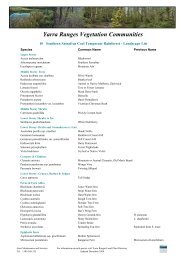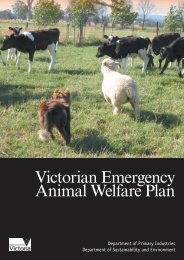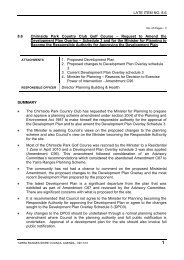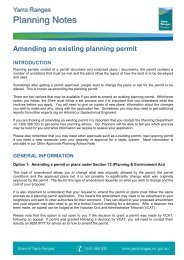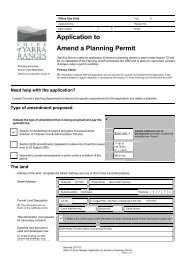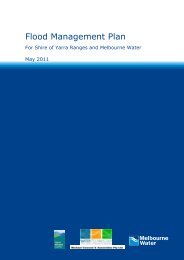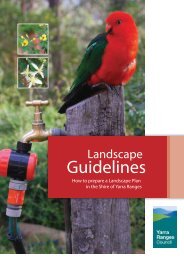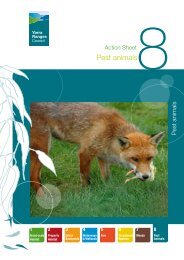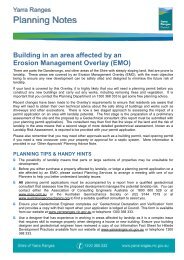Fa rm C h e m ical S p r a y A p p l ica t i o n - Shire of Yarra Ranges
Fa rm C h e m ical S p r a y A p p l ica t i o n - Shire of Yarra Ranges
Fa rm C h e m ical S p r a y A p p l ica t i o n - Shire of Yarra Ranges
Create successful ePaper yourself
Turn your PDF publications into a flip-book with our unique Google optimized e-Paper software.
C O D E O F P R A C T I C EF O RF a <strong>rm</strong> Chem<strong><strong>ica</strong>l</strong>SprayA p p l i c a t i o nChem<strong><strong>ica</strong>l</strong> Standards Branch
CONTENTS1 INTRODUCTION 51.1 Definitions 62 BEFORE SPRAYING 82.1 Chem<strong><strong>ica</strong>l</strong>s 102.2 Training and instruction 102.3 The fa<strong>rm</strong> chem<strong><strong>ica</strong>l</strong> label 113 WEATHER CONDITIONS 124 STORAGE, MIXING, AND DISPOSALOF FARM CHEMICALS 144.1 Storage 144.2 Mixing 144.3 Disposal 15ISBN 0 7306 41783Department <strong>of</strong> Natural Resources and Environment475 - 485 Mickleham RoadAttwoodVIC 3049Australia5 SPRAY EQUIPMENT AND PRACTICE 175.1 Maintenance 175.2 Droplet size 185.3 Calibration 195.4 Equipment to reduce spray drift 195.5 Cleaning <strong>of</strong> sprayer after use 20
2BEFORESPRAYINGBefore spraying is started first establish if a pest hascaused the problem. Poor nutrition, waterlogging,etc. may produce similar symptoms. The problemcould be caused by a combination <strong>of</strong> factors. Identifythe weed, insect, fungus, parasite or other pest, thendete<strong>rm</strong>ine if it is present at a level which is likely tocause economic damage.Consider all possible control methods:• mechan<strong><strong>ica</strong>l</strong> – ploughing, hoeing, etc.• cultural – hygiene strategies, crop rotations, etc.• chem<strong><strong>ica</strong>l</strong> – herbicide, fungicide, etc.• biolog<strong><strong>ica</strong>l</strong> – predator release, Bt, etc.If chem<strong><strong>ica</strong>l</strong> control is to be used, the fa<strong>rm</strong> chem<strong><strong>ica</strong>l</strong>must be registered for use. Choose the fa<strong>rm</strong>chem<strong><strong>ica</strong>l</strong> that is most appropriate for the job, whilebeing the least toxic to the operator, to beneficialinsects and to the environment. The fa<strong>rm</strong> chem<strong><strong>ica</strong>l</strong>must not be prohibited for use with that crop, pest, orappl<strong>ica</strong>tion method.OFF-LABEL USE is the appl<strong>ica</strong>tion <strong>of</strong> a registered fa<strong>rm</strong>chem<strong><strong>ica</strong>l</strong> in a way not exactly specified on the label.Generally an <strong>of</strong>f-label use within certain limits (seebelow for details) is not illegal in Victoria and isintended to enable the use <strong>of</strong> agricultural chem<strong><strong>ica</strong>l</strong>sin situations where extending label uses may beuneconom<strong><strong>ica</strong>l</strong>, such as minor crops. However, <strong>of</strong>flabeluse is not recommended by DNRE and does nothave manufacturers’ warranty. In Victoria, a group <strong>of</strong>restricted fa<strong>rm</strong> chem<strong><strong>ica</strong>l</strong>s must not be used <strong>of</strong>f-label,but a pe<strong>rm</strong>it may be obtained allowing such use –this pe<strong>rm</strong>it is different to an ACUP (AgriculturalChem<strong><strong>ica</strong>l</strong> User’s Pe<strong>rm</strong>it); these chem<strong><strong>ica</strong>l</strong>s and thecontrols over them are described in section 9.2.It is illegal to use a chem<strong><strong>ica</strong>l</strong> <strong>of</strong>f-label:• if the chem<strong><strong>ica</strong>l</strong> is a specified agricultural chem<strong><strong>ica</strong>l</strong>(see section 9)• in a manner which is prohibited on the label by a specificstatement (i.e. Do not use by aerial appl<strong>ica</strong>tion)• at a higher rate than the maximum rate for thatuse on the label• more frequently than stated on the label• if the use would breach a State prohibition (seeProhibited Uses <strong>of</strong> Agricultural Chem<strong><strong>ica</strong>l</strong> Products,page 45)If <strong>of</strong>f-label use is undertaken the user is liable for:• any unacceptable residues in the produce• any undesirable occupational health and safety,environmental or eff<strong>ica</strong>cy effects.NOTE: Chem<strong><strong>ica</strong>l</strong> companies do not accept reponsibilityfor any problems caused by chem<strong><strong>ica</strong>l</strong>s that areused <strong>of</strong>f-label.8 9
3WEATHERCONDITIONS• anemometers• wind speed chart• weather station• smoke generator.Section 5.4 discusses equipment that reduces driftand Section 6.1 other contributing hazards.It is the user’s responsibility to ensure that the chem<strong><strong>ica</strong>l</strong>stays in the target area. The user has a legal obligationto avoid spray-drift damage.Weather conditions can influence the effectiveness<strong>of</strong> spray, by for example, moving spray <strong>of</strong>f-target, orstressing the plant.Avoid spraying in the weather conditions listedbelow:• winds greater than 15 km/h (8 knots) for groundbasedappl<strong>ica</strong>tion• sea breezes and other winds caused by heating andcooling <strong>of</strong> the land throughout the day• visible dust movement• inversion layer at an altitude <strong>of</strong> less than 100 m• still and frosty conditions• low relative humidity (dry)• high temperatures• rain forecast.The following tools can be used to estimate or measurewind speed and direction:12 13
4STORAGE,MIXING, ANDDISPOSAL OFFARMCHEMICALS4.1 StorageA list <strong>of</strong> all chem<strong><strong>ica</strong>l</strong>s held in storage should be kept.Storage and transport <strong>of</strong> agricultural chem<strong><strong>ica</strong>l</strong>s thatare also dangerous goods must comply with theDangerous Goods Act 1985 and the Dangerous Goods(Storage and Handling) Regulations.Follow storage instructions on the chem<strong><strong>ica</strong>l</strong> label.Minimum storage standards are:• Lock chem<strong><strong>ica</strong>l</strong>s away from children and animals.• Keep chem<strong><strong>ica</strong>l</strong>s separate from seeds, fertilisers,protective clothing and stock-feed.• Always keep chem<strong><strong>ica</strong>l</strong>s in the original container.• Check stored containers regularly for deterioration (seeSection 8.1 on how to deal with leaking containers).• Buy as needed, do not stockpile chem<strong><strong>ica</strong>l</strong>s.• Store in cool conditions, away from direct sunlight.4.2 MixingMixing should be carried out in a well-ventilatedarea with adequate lighting. The area should be tidyso that it does not provide any hazards that mayresult in slipping or tripping.The mixing area must not drain to a waterway orsewer.There should be a convenient personal washdownfacility on the mixing site and a ready supply<strong>of</strong> clean water for personal washing available duringspraying.Use appropriate safety equipment and protectiveclothing as specified on the label.<strong>Fa</strong><strong>rm</strong> chem<strong><strong>ica</strong>l</strong>s should be decanted in a way thatminimises the risk <strong>of</strong> operator contact with chem<strong><strong>ica</strong>l</strong>s.Steps should be taken to minimise the risk <strong>of</strong>chem<strong><strong>ica</strong>l</strong> spillage.E n s u re that a non-re t u rn valve is fitted to any hoseor pipe which is used to fill the spray tank with water,p a rticularly where the hose is submerged while filling.This is very important and will prevent siphoning backf rom the tank into the water source if supply is interrup t e d .Agitation should be sufficient to keep fa<strong>rm</strong> chem<strong><strong>ica</strong>l</strong>sthoroughly mixed and suspended.Triple rinse empty containers and drain rinse waterinto the spray tank.4.3 DisposalFollow label instructions for disposal <strong>of</strong> chem<strong><strong>ica</strong>l</strong> andcontainer.Small quantities <strong>of</strong> unused dilute chem<strong><strong>ica</strong>l</strong> whichremain at the end <strong>of</strong> a spray job can be disposed <strong>of</strong> byfurther dilution (at least 10-fold) and then by applyingthe further diluted mixture to part <strong>of</strong> the targetarea. This appl<strong>ica</strong>tion, however, should be done so as14 15
not to wash <strong>of</strong>f the already applied chem<strong><strong>ica</strong>l</strong> and withthe equipment operating as per the original appl<strong>ica</strong>tion.Contaminated water should not be allowed todrain into ground water, sto<strong>rm</strong> drains, sewers orwater supplies.Concentrated chem<strong><strong>ica</strong>l</strong>s should never be disposed<strong>of</strong> on-fa<strong>rm</strong>. Disposal <strong>of</strong> chem<strong><strong>ica</strong>l</strong>s must be carried outby a licensed waste disposal company or as specifiedby EPA guidelines.All containers should be emptied and triple rinsedbefore disposal. Rinse water should be emptied intothe spray tank.To minimise container waste always try to (inorder <strong>of</strong> preference):• P u rchase chem<strong><strong>ica</strong>l</strong>s in containers that do notrequire disposal, e.g. water soluble sachets.• Purchase chem<strong><strong>ica</strong>l</strong>s in refillable containers that canbe returned to reseller.• Dispose <strong>of</strong> container through Avcare, BHP smelteror other commercial disposal program.• Puncture or crush triple rinsed container, then dispose<strong>of</strong> it at an approved municipal land fill tip.5SPRAYEQUIPMENTANDPRACTICE5.1 MaintenanceSpray equipment should be maintained to the manufacturer’sspecif<strong>ica</strong>tions, and the standards listedbelow.• Nozzles should be replaced whenever worn ordamaged. Nozzles should be replaced when thereis a 10% increase over the rated output <strong>of</strong> the nozzle,or every season if the rate is not checked.• Spray equipment should be maintained in goodorder:– hoses free <strong>of</strong> kinks, twists, cracks or splits– filters clean and functional andchecked on everyuse.• The sprayer’s pressure gauge should be checkedannually against a new or calibrated pressuregauge.• Nozzle position and angle should be visuallychecked before every spray operation.• Stabilisers on boom sprayers should be checked forproper operation at the beginning <strong>of</strong> every season.16 17
5.2 Droplet sizeSelect the nozzle or sprayer settings that produce thelargest size droplet (coarsest spray) suitable to perfo<strong>rm</strong>the spray appl<strong>ica</strong>tion.Droplet size is affected by the atomiser type andsprayer settings. The production <strong>of</strong> very fine droplets(less than 50 µm) should be avoided due to thei n c reased likelihood <strong>of</strong> drift and evaporation.Atomisers with higher flow rates generally producecoarser droplets. Many chem<strong><strong>ica</strong>l</strong> mixes give similardroplet size to water but ultra low volume (ULV) fo<strong>rm</strong>ulations,additives and some other fo<strong>rm</strong>ulationtypes can alter droplet size.The type <strong>of</strong> nozzle or atomiser and the way it isoperated influence the size <strong>of</strong> the droplets sprayed.Listed below are nozzles and the droplet size theyproduce.HYDRAULIC NOZZLES (British Crop Protection nozzlerating)• nozzle type – full cone (coarse droplets)– flood (coarse droplets)– flat fan (medium droplets)– hollow cone (fine droplets)• decreasing nozzle size – decreases droplet size• i n c reasing operating pre s s u re – decreases droplet size• increasing spray angle (i.e. 110° flat fan nozzle isfiner than 80° for same flow rate) – decreasesdroplet size.CONTROLLED DROPLET APPLICATOR (CDA) (FINEDROPLETS)• increasing rotation speed <strong>of</strong> spinning disk, drum orcage – decreases droplet size• decreasing flow rate – decreases droplet size.AIR SHEAR (FINE)• increasing speed <strong>of</strong> air passing the chem<strong><strong>ica</strong>l</strong> outlet– decreases droplet size• decreasing flow rate – decreases droplet size.5.3 CalibrationThe sprayer should be calibrated regularly to ensurethe correct appl<strong>ica</strong>tion rate. The calibration shouldensure that the correct amount <strong>of</strong> chem<strong><strong>ica</strong>l</strong> is appliedfor the type and arrangement <strong>of</strong> equipment andtravel speed. Marking should be carried out to avoidmissed strips and over-spraying.Calibration <strong>of</strong> the spray unit should be conducted:• every season• whenever appl<strong>ica</strong>tion or chem<strong><strong>ica</strong>l</strong> rate is changed• whenever nozzles are changed• at 50% <strong>of</strong> anticipated life <strong>of</strong> nozzles.Travel speed should be checked for the gear andrevs used for calibration, preferably on the sameslope and surface that spraying will occur.5.4 Equipment to reduce spray driftLO W D R I F T N O Z Z L E S a re very similar to a no<strong>rm</strong>al flat fannozzle. There is a plate with a small hole in the nozzlethat reduces the energy <strong>of</strong> the spray and thus makes itc o a r s e r, and slower leaving the nozzle. This reduces thenumber <strong>of</strong> fine droplets that are likely to drift.DIRECT SOIL INJECTION SYSTEMS have sprays attachedto tines which spray into the soil as the tine breaksand lifts the soil. No spray drift is possible due tospray confinement beneath the soil. Vapour drift isstill possible.18 19
AIR-ASSISTED SPRAYERS provide directed air whichblows the spray onto the target and into a cropcanopy. The air can assist the spray moving againstthe wind.ELECTROSTATIC SPRAYERS charge droplets electrostat<strong><strong>ica</strong>l</strong>lyso that they are attracted to anything that hasthe opposite charge or is grounded.TWIN FLUID SYSTEMS inject compressed air into thespray at the nozzle. Droplet size can be maintained ata lower volume rate because air pressure, not liquidpressure, is used to atomise the liquid.SHIELDED BOOM SPRAYERS control drift as a phys<strong><strong>ica</strong>l</strong>barrier that contains the spray cloud, or as an aerodynamicguide which controls the flow <strong>of</strong> air aroundthe nozzle. The controlled flow <strong>of</strong> air is less turbulentand minimises the volume <strong>of</strong> droplets carried awayfrom the target. Also, the air flow can force dropletsdown onto the target. Some shields are a combination<strong>of</strong> both concepts.STANDARD EQUIPMENT can be modified to reducespray drift by selecting a coarser nozzle; reducingspray pressure; or angling the nozzles forward so theboom can be lowered.• Flush clean water through equipment (at least 10 Lper nozzle), with nozzles removed so dirt is rinsedout <strong>of</strong> lines.• Remove nozzles and filters, wash and replace.• Never leave spray material in spray unit (seeSection 4.3 for disposal <strong>of</strong> unused spray material).5.5 Cleaning <strong>of</strong> sprayer after useFollow label instructions. If in doubt contact thereseller or chem<strong><strong>ica</strong>l</strong> company.Decontamination procedures should be followed asrecommended on the label. Where no other directionsare given it is desirable to:• Clean exterior <strong>of</strong> spray equipment and tractor.20 21
6PREVENTINGDAMAGEFROMSPRAYOPERATIONS6.1 Spray driftCheck conditions during spraying, and stop sprayingif adverse conditions arise (Note Section 3 ‘Weatherconditions’). Table 1 gives an ind<strong>ica</strong>tion <strong>of</strong> when therisk <strong>of</strong> drift is high or low. Most appl<strong>ica</strong>tions will havemany factors in a middle range or low range. If multiplefactors represent a high hazard <strong>of</strong> drift then theappl<strong>ica</strong>tion should be delayed until one or more <strong>of</strong>the factors has changed, which has resulted in therebeing less chance <strong>of</strong> <strong>of</strong>f-target drift.6.2 Buffer zones and vegetative barriersA buffer zone is an area around a sensitive area inwhich agricultural chem<strong><strong>ica</strong>l</strong>s should not be applied.The presence <strong>of</strong> a buffer zone enables spray drift tosettle out <strong>of</strong> the air stream as it travels across thebuffer zone before reaching the sensitive area. It isdifficult to define a safe buffer distance.Vegetative barriers between sensitive areas andfa<strong>rm</strong> chem<strong><strong>ica</strong>l</strong> appl<strong>ica</strong>tion areas can be effective inreducing spray-drift movement by filtering spraydroplets out <strong>of</strong> the air. A vegetative buffer is a row <strong>of</strong>trees, tall grass or bushes which reduces spray driftby filtering spray droplets through their foliage.A good vegetative buffer should be:• taller than the target plants or the spray unit usedfor chem<strong><strong>ica</strong>l</strong> appl<strong>ica</strong>tion• trees or other plants with foliage thin enough foryou to see through (50% porosity)• plants with long, thin, rough foliage, are moresuitable as a vegetative barrier.Examples <strong>of</strong> suitable plants:• casuarina or sheoak (Allocasuarina spp.)• hybrid willows (evergreen only)• rye corn• sorghum• bottlebrush (Callistemon spp.)• tea tree (Leptospe<strong>rm</strong>um spp.).Vegetative buffers are desirable:• on crop or property boundaries• next to sensitive areas such as susceptible crops,residential areas, etc.• along sprinkler rows, bordering waterways• between blocks or paddocks.What NOT to do• Do not attempt to use banks, buildings or densetrees such as cypress trees as a buffer.• Do not attempt to use vegetative buffers as a substitutefor good spray management practice.NOTE: A vegetative buffer will not reduce vapourdrift or odour associated with spray drift.22 23
Table1 Risk <strong>of</strong> drift<strong>Fa</strong>ctorPotential drift hazard scaleComment<strong>Fa</strong>ctorPotential drift hazard scaleCommentHighLowWind speedWind directionHighStill air or greaterthan 15 km/hrUnpredictable ortowards sensitiveareasLowSteady wind(1-10 km/hr)Predictable andaway fromsensitive areasTargeting <strong>of</strong>sprayDrop sizeDirected abovetargetDirected attargetVMD 200 µmTravel speed >20 km/h 30°C)Close (1.5 m abovetargetRelative humidity>80%No inversionlayerLow (1 km)Distance >100 mLive shelter, > 2xrelease height,p e <strong>rm</strong>eability 50%Chem<strong><strong>ica</strong>l</strong>s withLD 50 dose>5000 mg/kgLow (vapourpressure
• Use the right water rate for the soil type.• Do not spray when rain is likely.• Avoid over- i rrigating after appl<strong>ica</strong>tion <strong>of</strong> chem<strong><strong>ica</strong>l</strong>s.6.4 Provision <strong>of</strong> info<strong>rm</strong>ation6.4.1 RequestsIf any person has made a reasonable request for notif<strong>ica</strong>tion<strong>of</strong> spraying operations it should be provided.Examples <strong>of</strong> reasonable requests are:• apiarists who need to move bees• a q u a c u l t u re operator (ponds may need to becovered)• principal <strong>of</strong> adjoining school• the responsible person at adjoining public gatheringplace.6.4.2 ContractorsInfo<strong>rm</strong>ation should be given to a contractor aboutany sensitive areas including occupied areas, waterways,sensitive crops, fauna and flora within 100 m<strong>of</strong> the spraying operations. A contractor should neverbe requested to spray in conditions with a high risk<strong>of</strong> spray drift.Contractors must make and retain for two (2)years records <strong>of</strong> chem<strong><strong>ica</strong>l</strong> appl<strong>ica</strong>tions as detailed inSection 9.1, ‘Record keeping re q u i rements’. Anemployer can request a copy <strong>of</strong> that info<strong>rm</strong>ationfrom the contractor.7 SAFETYSafety standards must be maintained in compliancewith the Occupational Health and Safety Act 1985 andrelated regulations. This act is administered by theVictorian WorkCover Authority.7.1 Protective clothingProtective clothing should always be worn as recommendedon the product label when working withfa<strong>rm</strong> chem<strong><strong>ica</strong>l</strong>s. It is the employer’s responsibility tosupply protective clothing and ensure that it is usedand maintained.When use <strong>of</strong> a respirator is specified its use andm a n u f a c t u re should comply with AustralianStandards 1715-1994 and 1716-1994 (noted on respiratorpacket).Whenever handling chem<strong><strong>ica</strong>l</strong>s the minimum protectiveclothing that should be worn is:• washable or disposable overalls• washable hat• rubber or PVC gloves• rubber boots.26 27
If concentrated chem<strong><strong>ica</strong>l</strong> is handled also wear:• PVC apron• face shield.Clothing and equipment should be checked andcleaned after every day’s use.• Damaged safety equipment should be replacedimmediately.• Washing <strong>of</strong> protective clothing should be carriedout separately from household washing.• When any clothing is heavily contaminated byconcentrate it must be disposed <strong>of</strong> safely.7.2 PrecautionsNEVER eat, drink or smoke when using fa<strong>rm</strong>chem<strong><strong>ica</strong>l</strong>sNEVER touch a contaminated item to face or mouthand never rub eyes while wearing contaminated gloves.NEVER blow through hoses or nozzles to clear themand never suck on a hose to start siphoning.It is ILLEGAL and dangerous to store fa<strong>rm</strong> chem<strong><strong>ica</strong>l</strong>sin unlabelled containers or transfer to anynon-original containers such as s<strong>of</strong>t drink bottles.NEVER use the product if it is unlabelled or if thereis any doubt as to the identity <strong>of</strong> the chem<strong><strong>ica</strong>l</strong>.ALWAYS immediately wash hands or other skinexposed to chem<strong><strong>ica</strong>l</strong>s . Clean water, soap and a towelshould be carried whenever handling chem<strong><strong>ica</strong>l</strong>s.Use equipment that minimises contact with chem<strong><strong>ica</strong>l</strong>s,such as metering pumps, self-cleaning filtersand electronic spray controllers.Spraying should be avoided when a person isshowing symptoms <strong>of</strong> heat stress, headaches, colds,bronchitis or gastric upsets. These may mask theearly signs <strong>of</strong> poisoning. Heat stress can increase risk<strong>of</strong> poisoning.If symptoms <strong>of</strong> poisoning occur, spraying shouldcease immediately and med<strong><strong>ica</strong>l</strong> advice be sought.For the safe use <strong>of</strong> tractor cabs:• Contaminated clothing or equipment should notbe taken into the cabin.• Only use approved pesticide filters.• Filters should be changed regularly.• Tractor cabs with no appropriate pesticide filters donot provide protection from chem<strong><strong>ica</strong>l</strong> vapour; personalprotective equipment should be worn asadvised by the label.Spray should be kept downwind <strong>of</strong> the operator. If itis not possible a respirator and hood should be wornin addition to no<strong>rm</strong>al protective clothing.7.3 Preventing accidents to childrenALWAYS keep fa<strong>rm</strong> chem<strong><strong>ica</strong>l</strong>s in locked storage andout <strong>of</strong> reach <strong>of</strong> children.NEVER allow children to be present when sprayingor mixing chem<strong><strong>ica</strong>l</strong>s.NEVER keep chem<strong><strong>ica</strong>l</strong>s in containers similar to foodor drink containers.EDUCATE children about the hazards involved withchem<strong><strong>ica</strong>l</strong>s.28 29
8EMERGENCYSITUATIONS8.1 Leakages and spillsSTANDARD PRECAUTIONS• An emergency plan should be prepared to dealwith a spill.• Emergency equipment should be available including:– protective clothing and equipment– soil, sand or ve<strong>rm</strong>iculite– equipment and material recommended on thelabel.• Obtain advice from the Country Fire Authority(CFA).IMMEDIATE ACTIONS• For major spills call the CFA for help.• Keep bystanders away from the spill.• Do not hose down as this will spread the contamination.If as a result <strong>of</strong> a chem<strong><strong>ica</strong>l</strong> spill a person is injured andre q u i res med<strong><strong>ica</strong>l</strong> treatment, or someone in theimmediate vicinity <strong>of</strong> the spill is exposed to a healthor safety risk, then the spill must be reported to theVictorian WorkCover Authority.CLEAN UP OPERATION• Wear full protective clothing recommended onchem<strong><strong>ica</strong>l</strong> label.• Where possible alter position <strong>of</strong> the leaking containerto minimise leakage or decant to anothercontainer then label properly; return uncontaminatedsolid chem<strong><strong>ica</strong>l</strong> to its container.• Use sand or soil to prevent the spread <strong>of</strong> chem<strong><strong>ica</strong>l</strong>;use ve<strong>rm</strong>iculite or sand to soak up the chem<strong><strong>ica</strong>l</strong>from small spills; never use sawdust.• Follow label cleaning instructions to clean area.• Absorb excess liquid with sand or soil; dispose <strong>of</strong>all contaminated materials following EPA guidelines.8.2 FireSTANDARD PRECAUTIONS• An emergency plan should be prepared.• Practise a fire drill.• Ensure appropriate warning signs and placardingare in place on chem<strong><strong>ica</strong>l</strong> stores.• Store chem<strong><strong>ica</strong>l</strong>s separately from fuel.• Keep a Dry Powder Fire Extinguisher at thechem<strong><strong>ica</strong>l</strong> store.• Obtain advice from the CFA.WHEN A CHEMICAL FIRE STARTS• Raise the ala<strong>rm</strong>.• Obtain expert help; call the CFA.• Move all people upwind (evacuate from downwind).• When fire is out treat as a spill.30 31
8.3 PoisoningFollow first aid instructions on the chem<strong><strong>ica</strong>l</strong> label andcall the Poison Info<strong>rm</strong>ation Centre or a doctor.Remember to do the following:• Remove the cause <strong>of</strong> contamination from the casualtyby washing and removal <strong>of</strong> contaminated clothing.• If affected by chem<strong><strong>ica</strong>l</strong> vapour, move the casualtyto well-ventilated area.• Those helping the casualty should avoid contamination.The Poison Info<strong>rm</strong>ation Centre is a 24-hour, 7 daysa-weekservice.POISON INFORMATION CENTRE Ph. 131 126OR ph 000 in some rural exchange areasTo help the Poison Info<strong>rm</strong>ation Centre assess the situation,establish:• name <strong>of</strong> the chem<strong><strong>ica</strong>l</strong> or product; if possible take alabelled container to the phone• age <strong>of</strong> patient• type <strong>of</strong> contact (swallowed, inhaled, skin)• quantity and strength <strong>of</strong> contact substance• time since first contact• patient’s current condition• treatment already given.Keep a fully stocked First Aid Kit available at alltimes. Include any items that the chem<strong><strong>ica</strong>l</strong> label recommendsin the case <strong>of</strong> accidents, such as an eyewash or Ipecac syrup (consult the label and yourlocal pha<strong>rm</strong>acist). Keep a supply <strong>of</strong> fresh water availableto wash contaminated skin or eyes.If med<strong><strong>ica</strong>l</strong> treatment was required the VictorianWorkCover Authority must be notified.9 LEGISLATIONThis section outlines the re q u i rements withrespect to the Agricultural and Ve t e r i n a ry Chem<strong><strong>ica</strong>l</strong>s( C o n t rol <strong>of</strong> Use) Act 1992 and related re g u l a t i o n s ,that must be complied with when using agriculturalchem<strong><strong>ica</strong>l</strong>s. These controls are administered bythe Department <strong>of</strong> Natural Resources and Enviro n -ment in Victoria.The users <strong>of</strong> agricultural chem<strong><strong>ica</strong>l</strong>s should also beaware <strong>of</strong> the requirements <strong>of</strong> the Occupational Healthand Safety Act, the Environment Protection Act, theDangerous Goods Act and their respective regulations.Details <strong>of</strong> the requirements <strong>of</strong> chem<strong><strong>ica</strong>l</strong> users withrespect to these Acts is beyond the scope <strong>of</strong> this document.However, a list <strong>of</strong> relevant Acts and the associatedregulations is provided for further reference inSection 11.9.1 Record keeping requirements foragricultural chem<strong><strong>ica</strong>l</strong> usersA person who uses agricultural chem<strong><strong>ica</strong>l</strong> productswhich contain a substance listed below must make32 33
and keep (for a period <strong>of</strong> 2 years) accurate writtenrecords <strong>of</strong> their use.NOTE: This control only applies to agricultural chem<strong><strong>ica</strong>l</strong>products, not animal health products.People using these chem<strong><strong>ica</strong>l</strong>s must hold anAgricultural Chem<strong><strong>ica</strong>l</strong> User Pe<strong>rm</strong>it (ACUP) or beunder the direct supervision <strong>of</strong> an ACUP holder. Theuse <strong>of</strong> these specific chem<strong><strong>ica</strong>l</strong>s is restricted to labeluses unless a specific <strong>of</strong>f-label pe<strong>rm</strong>it is obtainedfrom DNRE.The chem<strong><strong>ica</strong>l</strong>s included in these requirement are:• Any Schedule 7 poison which is an agriculturalchem<strong><strong>ica</strong>l</strong>. Some examples <strong>of</strong> the active constituentsin some S7 products are: ald<strong>ica</strong>rb,dichlorvos, endosulfan, fenamiphos, methomyl,mevinphos, paraquat, parathion, etc. (This doesnot include animal health products, or veterinarypreparations.)and• Atrazine, metham sodium and Ester fo<strong>rm</strong> u l a t i o n s<strong>of</strong> MCPA; or 2,4-D; or t r i c l o p y r.These re c o rds must contain the info<strong>rm</strong>ation asdetailed below, and must be in a fo<strong>rm</strong> that can beeasily retrieved, and is understandable to others.1 Name and address <strong>of</strong> chem<strong><strong>ica</strong>l</strong> supplier2 Name and quantity <strong>of</strong> chem<strong><strong>ica</strong>l</strong> product3 Batch number, and where appl<strong>ica</strong>ble expiry date<strong>of</strong> the chem<strong><strong>ica</strong>l</strong> product4 Any specific written precautions received withthe chem<strong><strong>ica</strong>l</strong> product in addition to the label5 Withholding period6 Address or location <strong>of</strong> treated area7 Type <strong>of</strong> vegetation in the treated area8 Name <strong>of</strong> pest or disease to be controlled or erad<strong>ica</strong>ted9 Weather conditions at time <strong>of</strong> appl<strong>ica</strong>tion includingtemperature, wind direction, and speed10 Date and time <strong>of</strong> appl<strong>ica</strong>tion11 Rate and method <strong>of</strong> appl<strong>ica</strong>tion12 Name and address <strong>of</strong> person applying the chem<strong><strong>ica</strong>l</strong>,or if appl<strong>ica</strong>ble the person supervising theappl<strong>ica</strong>tion <strong>of</strong> the chem<strong><strong>ica</strong>l</strong>13 Details <strong>of</strong> any pe<strong>rm</strong>it issued by either DNRE orthe National Registration Authority.9.2 Licensing and pe<strong>rm</strong>it requirements foragricultural chem<strong><strong>ica</strong>l</strong> usersLicences are required by people involved in the business<strong>of</strong> agricultural spraying, using aircraft or groundbased equipment. The following licences can beobtained upon appl<strong>ica</strong>tion to DNRE:• C o m m e rcial Operator Licence – required by personsoperating a business that provides groundbasedagricultural spraying services or are <strong>of</strong>feringsuch a service for fee or reward.• Agricultural Aircraft Operator Licence – requiredby persons operating an aerial spraying business.Pilots must operate under the licence <strong>of</strong> aAgricultural Aircraft Operator, and must themselveshold a Pilot (Chem<strong><strong>ica</strong>l</strong> Rating) Licence.P e <strong>rm</strong>its issued by the National RegistrationAuthority are required to apply agricultural chem<strong><strong>ica</strong>l</strong>sthat are:34 35
• unregistered, or• registered but are to be used:– at a rate higher than the maximum rate stated onthe label– more frequently than the use intervals specifiedon the label– in a manner or for a purpose the label specif<strong><strong>ica</strong>l</strong>lyprohibits.P e <strong>rm</strong>its issued by the DNRE (Chem<strong><strong>ica</strong>l</strong> StandardsBranch), are for:• the use <strong>of</strong> a registered chem<strong><strong>ica</strong>l</strong> the use <strong>of</strong> which isrestricted under State law (e.g. AgriculturalChem<strong><strong>ica</strong>l</strong> User Pe<strong>rm</strong>its)• the use <strong>of</strong> a specified chem<strong><strong>ica</strong>l</strong>,(the <strong>of</strong>f-label use <strong>of</strong>which is prohibited under State law – see Section9.1)• the use <strong>of</strong> a restricted agricultural chem<strong><strong>ica</strong>l</strong> in aChem<strong><strong>ica</strong>l</strong> Control Area.Table 2 Chem<strong><strong>ica</strong>l</strong>s TOTALLY prohibited for use within a CCA when appliedusing the specified methods <strong>of</strong> appl<strong>ica</strong>tionChem<strong><strong>ica</strong>l</strong>1 Any fo<strong>rm</strong>ulation <strong>of</strong> picloram2 Hexazinone applied as a liquid3 Sulfometuron methyl in any fo<strong>rm</strong>or fo<strong>rm</strong>ulation4 Triclopyr ester5 Ester fo<strong>rm</strong>ulations <strong>of</strong> - MCPA; or2,4-D; or 2,4-DBProhibited methodTable 3 Chem<strong><strong>ica</strong>l</strong>s Prohibited from use within a CCA by specified methods<strong>of</strong> appl<strong>ica</strong>tion unless a Pe<strong>rm</strong>it has been obtained from DNREChem<strong><strong>ica</strong>l</strong>Aerial spraying or misterappl<strong>ica</strong>tionAerial spraying or misterappl<strong>ica</strong>tionAerial spraying or misterappl<strong>ica</strong>tionAerial spraying or misterappl<strong>ica</strong>tionAll methods <strong>of</strong> appl<strong>ica</strong>tionProhibited method9.3 Chem<strong><strong>ica</strong>l</strong> Control Areas (CCA)There are eight (8) areas within Victoria that are designatedas Chem<strong><strong>ica</strong>l</strong> Control Areas. The location <strong>of</strong>these areas is shown in Figure 10, page 47, Map <strong>of</strong>Victoria showing Chem<strong><strong>ica</strong>l</strong> Control Areas (CCA).Within these areas during certain times <strong>of</strong> the yearsome specific herbicides (see Table 2) are prohibitedfrom being applied, using specified types <strong>of</strong> equipment.Other specific herbicides (see Table 3) areallowed to be used within a CCA only if a pe<strong>rm</strong>itallowing the use has been issued by DNRE.1 Any fo<strong>rm</strong>ulation <strong>of</strong>: chlorsulfuron;or clopyralid; or glyphosate; o<strong>rm</strong>etsulfuron methyl2 An amine fo<strong>rm</strong>ulation <strong>of</strong> - MCPA;or MCPB; or 2,4-D; or 2,4-DB; ord<strong>ica</strong>mba; or mecoprop; or triclopyrCCAS – TIMES OF YEAR WHEN OPERATIONALMallee and Mid-Murray CCA – 1 August until 30April the following yearGoulburn Valley CCA – 1 September until 30 Aprilthe following yearNorth Eastern CCA – 1 September until 30 April thefollowing yearRutherglen CCA – 1 September until 30 April thefollowing year36 37Aerial spraying or misterappl<strong>ica</strong>tionAerial spraying or misterappl<strong>ica</strong>tion
Melbourne CCA – all yearLindenow CCA – all yearOrbost CCA.– all yearBoisdale CCA – all year10AERIALAPPLICATION9.4 Equipment regulationsPeople who use chemigation equipment should beaware <strong>of</strong>, and adhere to the specif<strong>ica</strong>tions that arerequired for such equipment in the Agricultural andVeterinary Chem<strong><strong>ica</strong>l</strong>s (Control <strong>of</strong> Use) Regulations1996.These guidelines are given only to advise fa<strong>rm</strong>ers <strong>of</strong>their responsibilities when hiring an aerial spray contractorand are not intended as advice to aerial appl<strong>ica</strong>tors.A map <strong>of</strong> the area where a chem<strong><strong>ica</strong>l</strong> is to beapplied should be made. This map can be a sketch(not to scale) or a pr<strong>of</strong>essionally published map. Onthe map important features and distinguishing landmarksshould be marked including: North; paddocksto be sprayed (numbered); fence lines; overheadw i res; roads; railways; buildings; trees; tall stru c t u re s;and the landing strip (if within map limits). Sensitiveareas should be also marked on the map including:crops; houses (distinguished from other buildingsand numbered); schools; kindergartens; dams; channels;rivers; creeks; other waterways; and crownland. The map should ind<strong>ica</strong>te whether the waterwaysare wet or dry.The appl<strong>ica</strong>tor should be advised if the label warnsthat chem<strong><strong>ica</strong>l</strong>s should be kept away from people,fish, bees, certain sensitive crops or other sensitive38 39
areas. Aircraft are legally required to keep a minimumheight and distance <strong>of</strong> 100 m away from ahouse whether spraying or not, unless they havebeen given pe<strong>rm</strong>ission by the occupant. If pe<strong>rm</strong>issionto fly closer has been obtained from the occupant itshould be marked on the map.11FURTHERINFORMATIONDepartment <strong>of</strong> Natural Resources and EnvironmentBrochures: (Contact Chem<strong><strong>ica</strong>l</strong> Info<strong>rm</strong>ation Service(CIS), see below)• Wind Speed Char t• Protecting Waterways• Pesticide Risks to the User and the Environment (posterseries)• Use Agricultural Chem<strong><strong>ica</strong>l</strong>s Responsibly in VictoriaQueensland Department Primary Industry:• Pesticide Drift – Description, Causes and RemediesSources <strong>of</strong> general info<strong>rm</strong>ation:• the chem<strong><strong>ica</strong>l</strong> label• chem<strong><strong>ica</strong>l</strong> manufacturers or suppliers/resellers• Department <strong>of</strong> Natural Resources and Environment,Regional Chem<strong><strong>ica</strong>l</strong> Standards Off i c e r s(RCSOs)– Jim Stranger, Gippsland & Port Phillip EastPh. (03) 5172 2111 m. 0408 962 19140 41
– Alan Roberts, North WestPh. (03) 5430 4416 m. (0419) 505 485– Les Toohey, South West & Port Phillip WestPh. (03) 5573 0715 m. (0419)324 439– David Stewart, North EastPh. (03) 5761 1532 m. (0419) 116 759• DNRE, Chem<strong><strong>ica</strong>l</strong> Info<strong>rm</strong>ation Service (CIS):Ph. (03) 9210 9379Health info<strong>rm</strong>ation is available from:• your local council Environmental Health Officer• Department <strong>of</strong> Human Services Pest Control UnitPh. (03) 9637 4156• your local doctor.Info<strong>rm</strong>ation on the <strong>Fa</strong><strong>rm</strong> Chem<strong><strong>ica</strong>l</strong> Users Course isavailable from:• RCSOs as listed above• TAFE Course Line 131 823.Chem<strong><strong>ica</strong>l</strong> storage info<strong>rm</strong>ation is available from:• Victorian WorkCover Authority (VWA)– Dangerous Goods <strong>Fa</strong><strong>rm</strong>s Brochur e– Head <strong>of</strong>fice Ph. (03) 9641 1444 or 1800 136 089.Chem<strong><strong>ica</strong>l</strong> disposal info<strong>rm</strong>ation can be obtained from:• E PA Pollution Watchline – Ph. (03) 9695 2777• your local council Environmental Health Officer.For info<strong>rm</strong>ation on calibration <strong>of</strong> spraying equipment:• the manufacturer’s operation and maintenanceinstructions• DNRE• some chem<strong><strong>ica</strong>l</strong> resellers• the fa<strong>rm</strong> chem<strong><strong>ica</strong>l</strong> users course.For further info<strong>rm</strong>ation on chem<strong><strong>ica</strong>l</strong> leakages, spillsand fire contact:• your local CFA• E PA Pollution Watchline – Ph. (03) 9695 2777• Victorian WorkCover Authority (VWA)– Dangerous Goods <strong>Fa</strong><strong>rm</strong>s Brochur e– Head <strong>of</strong>fice ph. (03) 9641 1444 or 1800 136 089.• chem<strong><strong>ica</strong>l</strong> label and appropriate chem<strong><strong>ica</strong>l</strong> manufacturer.POISON INFORMATION CENTREPh. 131 126, or Ph. 000 in some rural exchange are a sTo apply for pe<strong>rm</strong>its that are issued by the NRA contact:Alan NordenNational Registration Authority for Agricultural andVeterinary Chem<strong><strong>ica</strong>l</strong>sPO BOX E240, Kingston ACT 2604Ph. (02) 6272 5158 <strong>Fa</strong>x (02) 6272 4735Relevant State legislationActs and legislation can be purchased fro mInfo<strong>rm</strong>ation Victoria Bookshop, 356 Collins Street,Melbourne, Ph. 1300 366 356. For further info<strong>rm</strong>ationthe administering department should be contacted.Relevant State legislation is listed below.• Agricultural and Veterinary Chem<strong><strong>ica</strong>l</strong>s (Control <strong>of</strong> Use)Act 1992• Agricultural and Veterinary Chem<strong><strong>ica</strong>l</strong>s (Control <strong>of</strong>Use) Regulations 1996 administered by Department<strong>of</strong> Natural Resources and Environment• Occupational Health and Safety Act 1985Occupational Health and Safety (Plant)Regulations 199540 41
• Occupational Health and Safety (IncidentNotif<strong>ica</strong>tion) Regulations 1997• Dangerous Goods Act 1985• Dangerous Goods (Storage and Handling)Regulations 1989• All above legislation administered by VictorianWorkCover Authority• Environmental Protection Act 1970 administered byEPA• Drugs Poisons and Controlled Substances Act 1981• Drugs Poisons and Controlled SubstancesRegulations 1995• Health Act 1958• Health (Pest Control Operator) Regulations 1992Above legislation is administered by theDepartment <strong>of</strong> Human Services12PROHIBITEDUSES OFAGRICULTURALCHEMICALPRODUCTS1 An agricultural chem<strong><strong>ica</strong>l</strong> product that contains aconstituent referred to in TABLE 1 is prohibited frombeing used for any purpose unless the use is a pe<strong>rm</strong>ittedpurpose stated in TABLE 1 for the respectiveconstituent.Table 1The info<strong>rm</strong>ation in this publ<strong>ica</strong>tion is <strong>of</strong>fered by theState <strong>of</strong> Victoria (the Department <strong>of</strong> NaturalResources and Environment) solely to provide info<strong>rm</strong>ation.While all due care has been taken in compilingthe info<strong>rm</strong>ation, the State <strong>of</strong> Victoria and its <strong>of</strong>ficersand employees take no responsibility for anyperson relying on the info<strong>rm</strong>ation, and disclaims allliability for any errors or omissions in the publ<strong>ica</strong>tion.ConstituentChlorfluazuronSodium Fluoroacetate (1080)tributyl tinPe<strong>rm</strong>itted purposeAny purpose stated on the labelthat is approved by the NationalRegistration Authority forAgricultural and VeterinaryChem<strong><strong>ica</strong>l</strong>sA ve<strong>rm</strong>in destroyer for thecontrol <strong>of</strong> foxes, rabbits, wilddogs, feral pigsAs an industrial timbertreatment, or in antifoulingmarine paint for vessels greaterthan 25 metres in length2 An agricultural chem<strong><strong>ica</strong>l</strong> product that contains aconstituent referred to in Table 2 is prohibited frombeing used for the purpose stated in Table 2 for therespective constituent.44 45
Table 2ConstituentAntibiotics, peroxide and perborateMetham SodiumMethiocarbParaquatMevinphos, parathion, parathionmethyl,methamidophos andchlorthiophosMevinphosProhibited purposeAs a dairy cleanerIn trickle irrigation systems. Infixed, portable or solid seti rrigation systems. In travellinggun, boom or side roll irr i g a t i o nsystems. In flood irrigation. Inany other irrigation system usingimpact sprinklers or in anyi rrigation systems operating athigh pre s s u re or those irr i g a t i o nsystems causing spray driftFor use on grapevines or as awettable powder in packsgreater than 15 grams forhome garden useWhen applied by back-mountedspraying equipmentWhen applied by back-mountedspraying equipmentAs a ve<strong>rm</strong>in destroyer for thecontrol <strong>of</strong> vertebrate pestsincluding rabbits, foxes andbirds46




